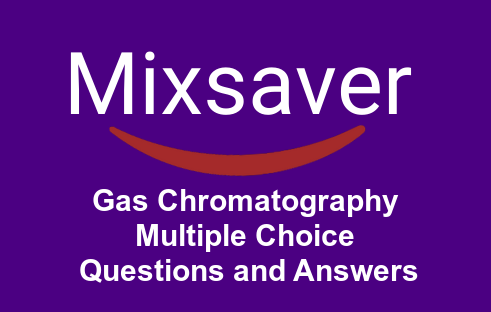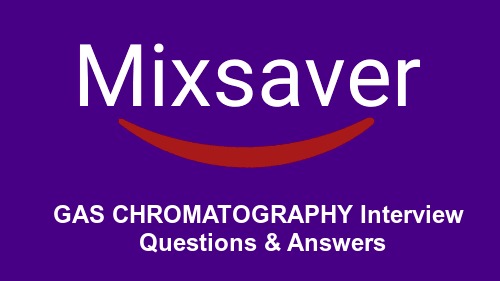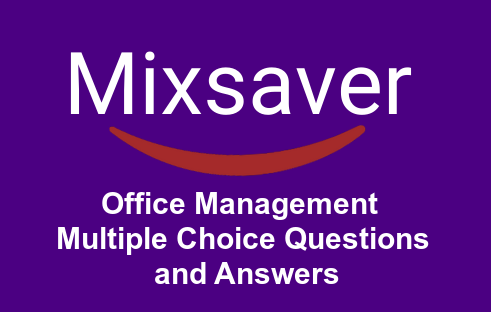Gas Chromatography MCQ | MCQ on Gas Chromatography
1. Separation of molecules on the basis of their partition coefficient is called
(a) electrophoresis
(b) centrifugation
(c) chromatography
(d) All of these
Ans. c
2. Separation of molecules on the basis of difference in charge is called
(a) electrophoresis
(b) centrifugation
(c) chromatography
(d) None of these
Ans. a
3. Molecular are separated on the basis of their sedimentation is called
(a) chromatography
(b) electrophoresis
(c) centrifugation
(d) None of these
Ans. c
4. Immunoblotting uses
(a) antigen
(b) antibody
(c) Both (a) and (b)
(d) None of these
Ans. b
5. Planer chromatography uses following stationary phase
(a) tube
(b) column
(c) cube
(d) None of these
Ans. d
6. Partition chromatography relies on
(a) man differences
(b) charge differences
(c) solubility differences
(d) None of these
Ans. c
7. Stationary phase is tubular in
(a) paper chromatography
(b) column chromatography
(c) absorption chromatography
(d) All of the above
Ans. b
8. Size exclusion chromatography separates the molecules on the basis of
(a) size
(b) shape
(c) Both (a) and (b)
(d) None of these
Ans. c
9. Action of opposite ion is utilised in
(a) affinity chromatography
(b) size exclusion chromatography
(c) ion exchange chromatography
(d) None of these
Ans. c
Multiple Choice Questions in Analytical Chemistry pdf | Analytical Chemistry MCQ Questions and Answers
10. Agarose and polyacrylamide gels are used in
(a) centrifugation
(b) chromatography
(c) microscopy
(d) None of these
Ans. d
11. Discontinuous gel electrophoresis uses
(a) sample gel
(b) stacking gel
(c) separating gel
(d) All of these
Ans. d
12. SDS is used in SDS page for
(a) equating the charge
(b) equating the mass
(c) Both (a) and (b)
(d) None of these
Ans. a
13. Ultracentrifuge has following RPM
(a) 40-60 K
(b) 20-40 K
(c) 5-10 K
(d) 60-70 K
Ans. c
14. Proteins are used in normal state in which of the following electrophoresis
(a) SDS page
(b) Native page
(c) Both (a) and (b)
(d) None of these
Ans. b
15. 2D page utilise how many direction
(a) 1
(b) 2
(c) 3
(d) 4
Ans. b
16. The maximum magnification possible with light microscopy is
(a) 400 X
(b) 500 X
(c) 1000 X
(d) 2000 X
Ans. c
17. The outline of a cell, nucleus, mitochondria and vacuoles are viewed with the help of
(a) bright field microscopy
(b) dark field microscopy
(c) fluorescent
(d) ultraviolet
Ans. b
18. The size of objects that can be seen with the light microscope is
(a) larger than 0.24
(b) larger than 1u
(c) larger than 1nm
(d) larger than 2A
Ans. a
19. The blank used to calibrate the spectrophotometer for testing the absorbance spectrum of chlorophyll is
(a) water
(b) acetone
(c) chlorophyll-a
(d) cobalt chloride
Ans. b
Multiple choice questions on analytical techniques | multiple choice questions on analytical method validation | analytical chemistry mcq questions and answers pdf | analytical chemistry mcqs | analytical chemistry multiple choice questions with answers pdf | analytical chemistry questions and answers multiple choice | analytical chemistry mcqs pdf | basic concept of analytical chemistry mcqs | mcq on analytical chemistry
20. The path followed by spectrophotometer is
(a) meter, photodetector, filter, sample, light source
(b) meter, sample, filter, light source, photodetector
(c) light source, filter, sample, photodector, meter
(d) light source, sample, filter, photodetector,
Ans. c
21. Microscopes that are will remain nearly focused after the low-power objective lens is changed to the high-power objective lens
(a) monocular
(b) parcentered
(c) parfocal
(d) properly adjusted
Ans. c
22. Which system consists of a camera and/or a video screen?
(a) Viewing and recording
(b) lluminating
(c) Imaging
(d) Contrasting
Ans. a
23. If the ocular of a microscope is 10X and the objective is set at 100X then what is the total magnification of the microscope?
(a) 10X
(b) 43X
(c) 1000X
(d) 430X
Ans. c
24. Always begin examining microscope slides with which power objective?
(a) High
(b) Low
(c) 100X
(d) It doesn’t matter which objective
Ans. b
25. What must be done to a specimen to increase the contrast of the structures viewed?
(a) Illuminated
(b) Stained
(c) Placed under a cover slip
(d) Thinly sliced
Ans. b
26. For which of the following specimens would you use a dissecting scope?
(a) Human skin cells
(b) E.coli
(c) Insect mouth parts
(d) Newspaper print
Ans. c
27. Which of these techniques is often considered a suitable ‘polishing’ step in a protein purification?
(a) Affinity Chromatography (AC)
(b) lon-Exchange Chromatography (IEX)
(c) Hydrophobic Interaction Chromatography (HIC)
(d) Size-Exclusion Chromatography (SEC)
Ans. d
28. What properties of a protein does hydrophobie interaction chromatography exploit for purification?
(a) Charged amino acids
(b) Hydrophobic amino acids on the protein surface
(c) Molecular weight
(d) Enzyme activity
Ans. b
29. To elute target proteins from an affinity chromatography matrix, which of the following conditions would be the most appropriate?
(a) Low salt concentrations
(b) High salt concentrations
(c) Adding a soluble ligand which competes with the atffinity tagged protein for binding to the column
(d) Just keep washing buffer through the column, isocratic elution
Ans. c
30. Which of the following methods could be used to check the molecular weight of your purified protein?
(a) SDS-PAGE
(b) Mass spectrometry
(c) Analytical SEC
(d) All of the above
Ans. d





